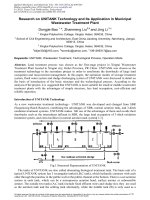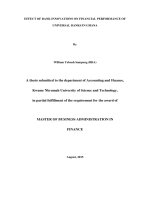technology and finance
Bạn đang xem bản rút gọn của tài liệu. Xem và tải ngay bản đầy đủ của tài liệu tại đây (2.11 MB, 397 trang )
Technology and Finance
Technology and Finance analyses the dramatic implications of technology for today’s
financial sector, for productivity growth and for monetary policy. A wide range of
financial market activities are now technology driven; technology is also crucial in
retail, private and corporate banking, and it has lowered entry barriers to the sector.
New participants are flourishing as they are strongly supported by their technology.
Distinguished keynote speeches in this volume were initially featured in the
latest highly-respected SUERF (Société Universitaire Européenne de Recherches
Financie`res) Colloquium. The articles cover the following topics:
●
●
●
The impact of technology on financial institutions – evolution or revolution?
The relationship between technology and financial markets, including the
impact of ‘electronification’ on financial markets and deposit insurance
systems.
The real and potential impact of technology on productivity growth, and possible implications for economic growth, monetary policy and markets.
This volume represents the cutting edge of informed thinking on the implications
of, and possible problems with, modern technology on contemporary finance.
Morten Balling is Professor of Finance at the Aarhus School of Business, Denmark.
He was president of the ASB from 1993–2001 and has been a council member of the
Société Universitaire Européenne de Recherches Financie`res (SUERF) since 1994.
Frank Lierman is Chief Economist at DEXIA Bank, Belgium. A council member of SUERF since 2000, he is also president of the editorial board of the Revue
Bancaire et Financie`re/Bank – en Financiewezen.
Andy Mullineux is Professor of Global Finance, and Director of the Global
Finance Research Group in the Department of Accounting and Finance at the
Birmingham Business School, University of Birmingham. His most recent publications include co-editing Finance, Governance and Economic Performance in
Pacific and South East Asia, and Economic Performance and Financial Sector
Reform in Central and Eastern Europe.
Routledge International Studies in Money and Banking
1 Private Banking in Europe
Lynn Bicker
2 Bank Deregulation and Monetary Order
George Selgin
3 Money in Islam
A study in Islamic political economy
Masudul Alam Choudhury
4 The Future of European Financial Centres
Kirsten Bindemann
5 Payment Systems in Global Perspective
Maxwell J Fry, Isaak Kilato, Sandra Roger, Krzysztof Senderowicz, David
Sheppard, Francisco Solis and John Trundle
6 What is Money?
John Smithin
7 Finance
A characteristics approach
Edited by David Blake
8 Organisational Change and Retail Finance
An ethnographic perspective
Richard Harper, Dave Randall and Mark Rouncefield
9 The History of the Bundesbank
Lessons for the European Central Bank
Jakob de Haan
10 The Euro
A challenge and opportunity for financial markets
Published on behalf of Société Universitaire Européenne de Recherches
Financie`res (SUERF)
Edited by Michael Artis, Axel Weber and Elizabeth Hennessy
11 Central Banking in Eastern Europe
Nigel Healey
12 Money, Credit and Prices Stability
Paul Dalziel
13 Monetary Policy, Capital Flows and Exchange Rates
Essays in memory of Maxwell Fry
Edited by William Allen and David Dickinson
14 Adapting to Financial Globalisation
Published on behalf of Société Universitaire Européenne de Recherches
Financie`res (SUERF)
Edited by Morten Balling, Eduard H. Hochreiter and Elizabeth Hennessy
15 Monetary Macroeconomics
A new approach
Alvaro Cencini
16 Monetary Stability in Europe
Stefan Collignon
17 Technology and Finance
Challenges for financial markets, business strategies and policy makers
Published on behalf of Société Universitaire Européenne de Recherches
Financie`res (SUERF)
Edited by Morten Balling, Frank Lierman and Andy Mullineux
Technology and Finance
Challenges for financial markets, business
strategies and policy makers
Edited by Morten Balling,
Frank Lierman
and Andy Mullineux
London and New York
First published 2003
by Routledge
11 New Fetter Lane, London EC4P 4EE
Simultaneously published in the USA and Canada
by Routledge
29 West 35th Street, New York, NY 10001
Routledge is an imprint of the Taylor & Francis Group
This edition published in the Taylor & Francis e-Library, 2004.
2003 editorial matter and selection, Morten Balling, Frank Lierman and
Andy Mullineux; individual chapters, the contributors
All rights reserved. No part of this book may be reprinted or reproduced or
utilized in any form or by any electronic, mechanical, or other means, now
known or hereafter invented, including photcopying and recording, or in
any information storage or retrieval system, without permission in writing
from the publishers.
British Library Cataloguing in Publication Data
A catalogue record for this book is available from the British Library
Library of Congress Cataloging in Publication Data
Technology and finance: challenges for financial markets, business
strategies, and policy makers / edited by Morten Balling, Frank Lierman,
and Andrew Mullineux.
p. cm.– (Routledge international studies in money and banking ; 17)
Includes bibliographical references and index.
ISBN 0-203-22261-X Master e-book ISBN
ISBN 0-203-27707-4 (Adobe eReader Format)
ISBN 0-415-29827-X (Print Edition)
1. Banks and banking – Technological innovations–Europe. 2. Banks and
banking–Technological innovations. 3. Financial
institutions–Technological innovations–Europe. 4. Financial
institutions–Technological innovations. 5. Financial services
industry–Technological innovations. I. Balling, Morten. II. Lierman,
Frank. III. Mullineux, A.W. IV. Series.
HG2974.T434 2002
332.1–dc21
2002026937
Contents
List of figures
List of tables
List of contributors
Acknowledgements
Introduction
x
xii
xiv
xvi
1
MORTEN BALLING
PART I
Survey lectures from plenary sessions
1 Central banking in an evolving environment
9
11
GUY QUADEN
2 The inter-temporal nature of risk
18
CHARLES GOODHART AND JON DANIELSSON
3 Technology and finance: challenges for financial markets,
business strategies and policy markets
41
DIDIER REYNDERS AND JEAN-PAUL SERVAIS
PART II
Contributions on technology and financial institutions
4 Technology and the new economics of banking:
a UK perspective
49
51
DAVID T. LLEWELLYN
5 The effects of technology on the costs and risks of
Spanish banks
IGNACIO FUENTES EGUSQUIZA AND TERESA SASTRE DE MIGUEL
68
viii
Contents
6 Consumer behaviour and the usage and adoption of remote
and direct banking in the United Kingdom
89
BARRY HOWCROFT
7 Employment perspectives in the German financial services
industry and the impact of information technology
112
RALF-HENNING PETERS AND PETER WESTERHEIDE
8 Technology and the (re)location of financial activity:
a European perspective
131
IMAN VAN LELYVELD AND MARIEKE DONKER
PART III
Contributions on technology and financial markets
163
9 Competition and consolidation in the European
exchange industry
165
OLIVIER LEFEBVRE
10 Alternative Trading Systems and liquidity
171
HANS DEGRYSE AND MARK VAN ACHTER
11 Where traders go when stock exchanges go virtual
– concentration, dissemination or persistence?
190
VIVIEN LO AND MICHAEL H. GROTE
12 Electronic trading and its implications for financial systems
204
HELEN ALLEN, JOHN HAWKINS AND SETSUYA SATO
PART IV
Contributions on technology and payments
239
13 Monetary policy in a cashless society
241
CLÁUDIA COSTA STORTI AND PAUL DE GRAUWE
14 The dynamics of payment networks
261
GOTTFRIED LEIBBRANDT
15 Electronic payments and scale properties in the
banking industry
KJERSTI-GRO LINDQUIST
290
Contents
16 Market structure, innovation and the development of
digital money
ix
302
PETER D. SPENCER
PART V
Contributions on technology and productivity
315
17 New economy in Europe – reality or mirage?
317
ANTJE STOBBE
18 Beyond the dot.coms
335
SIEGFRIED UTZIG
19 International productivity differences: explanations
and policy implications
350
JOHAN VAN GOMPEL
Index
371
List of figures
2.1
2.2
2.3
2.4
2.5
2.6
2.7
2.8
2.9
2.10
2.11
2.12
2A.1
4.1
4.2
5.1
5.2
5.3
5.4
5.5
6.1
6.2
7A.1
7A.2
7A.3
7A.4
8.1
8.2
8.3
8.4
8.5
Productivity growth: the long view
20
Average UK GDP growth (1850–2000)
21
Average UK GDP growth (1850–2000)
21
Average growth of UK real share prices (1854–2000)
22
Average growth of US real share prices (1871–2000)
22
Daily 1977–2001 FT 30
24
Daily 1977–2001 FT 30 extremes p = 1/500
25
Moving from extreme shocks back towards the middle
26
of the distribution
Long-run cycles in average volatility
27
VaR on a 100mn. Portfolio of the Hang Seng Index 1997
27
Real UK house prices and estimated loan-to-value ratios
31
Growth in real lending and simulated capital adequacy ratios
32
Real lending and simulated capital adequacy ratios
38
Institutional spectrum
64
Technology and economies of scale
65
Average spending per branch: big, small and medium-sized banks
73
Average spending per branch: savings banks and credit cooperatives 74
Efficiency indicators
76
Labour productivity (rate of change)
78
Total factor productivity (rate of change)
79
Consumer behaviour matrix
91
Six-cluster solutions and consumer behaviour matrix
102
Real gross value added
127
Real labour costs in the banking industry
127
Real labour costs in the insurance industry
127
Expected development of employment in the coming five years
128
Cost of a payment transaction (in dollars)
132
Kernal density estimation for GVA in European regions, 1980–95
141
Kernal density estimation for population-weighted
144–145
RGVA in European regions, 1980–92
Centres, adjoining regions and the periphery, 1980–95
146
Correlation of real GVA across borders, 1980–95
147
List of figures xi
8.6
8.7
8.8
8.9
8.10
8.11
8.12
9.1
9.2
10.1
11.1
11.2
12.1
12.2
13.1
13.2
14.1
14.2
14.3
14A.1
17.1
17.2
17.3
17.4
17.5
17.6
17.7
19.1
19.2
19.3
19.4
19.5
19.6
19.7
19.8
Moving average of correlations (lag 8)
Kernel density estimation for employment in European
regions, 1980–92
Kernel density estimation for population-weighted employment in
European regions, 1980–92
Employment in centre, adjoining and peripheral regions, 1980–92
Correlation of employment across borders, 1980–92
Kernel density estimation for efficiency in European
regions, 1980–92
Efficiency in centre, adjoining and periperal regions,
1980–92
The ‘Euronext’ view
Integration and openness within the ‘Euronext’ view
NASDAQ share volume of ECN
Proportion/probability – mapping
Changes in the relative importance of pull factors
Flowchart showing effects of innovation
Effects of electronic trading
The market for overnight balances
The market for overnight balances in a cashless society
Non-cash payment instruments across countries (1999)
Critical mass needed to adopt g
Cost of a giro transaction (constant 2000 a prices)
Occurrence of lock-in with upgrades
IT expenditure and GDP per capita (1999)
ICT spending per capita (EUR)
ICT spending (% GDP)
PCs (% of population)
Internet users (% of population)
TFP growth and ICT production share (1992–8) (%)
EMU: GDP and employment
Prosperity and productivity
Productivity trend (private sector, average annual
increase, in %)
International differences in labour productivity
(total economy, per worker, in PPP)
Relative level of labour productivity (total economy, in
PPP, USA = 100)
Investments in ICT (as % of GDP)
Productivity and regulation
Regulation of the product and labour market (1998)
Productivity, innovation and education
148
150
151
152
153
154
155
168
169
179
192
198
205
206
249
251
262
267
271
279
321
321
322
323
324
330
331
352
353
355
356
358
362
362
364
List of tables
2A.1
2A.2
5.1
5.2
5.3
6.1
6.2
6.3
6.4
6.5
7A.1
7A.2
7A.3
7A.4
8.1
8.2
8A.1
8A.2
10.1
10.2
10.3
10.4
Testing for the randomness of economic downturns: Poisson test
Testing for the randomness of economic downturns: exponential test
Indicators of information technology spending
Costs and activity: 1992–2000
Internet and e-banking penetration
Consumers’ acquisition of financial product by type of
delivery channel
Consumers’ preferred acquisition channel
Questionnaire items used for cluster variate
Measuring agreement between Ward’s method and the
K-means method
Six-cluster solution of the K-means cluster analysis with
initial seed points from Ward’s method
Estimation results for the labour demand system
Extent to which changes in employment are caused by
increasing use of ICT
Own-wage elasticities (mean of estimated elasticities
over time)
Negative impact of ICT use on employment in the coming
five years (in %)
Key characteristics of real gross value added and
employment in the financial sector, per country, 1980–95
Formal measures of inequality, 1980–90
Description of Eurostat data for gross value added
at market prices (GVA mp) or at factor cost (GVA fc), per country,
1980–95
Description of data on employment, per country,
1990–95
Total trading costs in 42 countries
Electronic trading systems in Europe
Impact of electronic trading systems on trading costs in
Europe
ECN characteristics (USA)
35
35
70
72
81
94
95
97
100
101
125
125
126
126
139
142
157
158
172
175
175
178
List of tables xiii
13.1
Comparison of seigniorage and central bank expenses
(1994) (% of GDP)
13.2 Consolidated balance sheets of the Eurosystem and of
the MFIs in Euroland (May 2000)
13.3 Reserve deposits held at the central banks as a share
of total bank liabilities
14.1 Critical mass for giro adoption in The Netherlands:
alternative assumptions
14.2 Share of international transactions for selected EU countries
14A.1 Giro systems in Europe
14A.2 Number of payment networks
15.1 The estimated cost function and cost-share equations
15.2 Own- and cross-price elasticities calculated at the overall
empirical mean of the cost shares
15.3 The elasticity of scale and elasticity of costs with respect
to electronic payments
15A.1 Summary statistics for the endogenous and
explanatory variables in the analysis
17.1 Growth sources in the EU and contribution of ICT sector
17.2 Decomposition of euro area labour productivity growth
17.3 Sectoral developments in the euro area (%)
17.4 Sectoral developments in the USA
17.5 Productivity estimates 1981–99
19.1 Acceleration in growth of labour productivity and
contributions in the USA
247
250
256
273
274
283
284
296
297
298
300
325
326
326
327
328–329
357
List of contributors
Helen Allen Adviser, Market Infrastructure Division, Bank of England, UK
Morten Balling Professor, Department of Finance, Aarhus School of Business,
Denmark
Cláudia Costa Storti Economist, Banco de Portugal, Lisboa, Portugal
Jon Danielsson Lecturer in Finance, Financial Markets Group, London School
of Economics, UK
Paul De Grauwe Professor, Centrum voor Economische Studiën, Katholieke
Universiteit Leuven, Belgium
Hans Degryse Economics Department, KU Leuvew, Belgium
Marieke Donker Researcher, De Nederlandsche Bank, Amsterdam, The
Netherlands
Ignacio Fuentes Egusquiza Senior Analyst, Servicio de Estudios, Banco de
España, Madrid, Spain
Charles Goodhart Professor, Banking and Finance, London School of
Economics, UK
Michael H. Grote Lecturer, Institute for Economics, Goethe-University,
Frankfurt/Main, Germany
John Hawkins Senior Economist, Bank for International Settlements, Basel,
Switzerland
Barry Howcroft Professor, Director, Banking Centre, Loughborough
University, UK
Olivier Lefebvre Executive Vice-President, Member of the Managing Board,
Euronext NV, Brussels, Belgium
Gottfried Leibbrandt McKinsey and Company, Amsterdam, The Netherlands
Frank Lierman Chief Economist, DEXIA Bank NV, Brussels, Belgium
List of contributors
xv
Kjersti-Gro Lindquist Senior Advisor, Research Department, Central Bank of
Norway, Oslo, Norway
David T. Llewellyn Professor, Department of Economics, Loughborough
University, UK
Vivien Lo Research Assistant/Lecturer, Institute for Economic and Social
Geography, Goethe-University, Frankfurt/Main, Germany
Andy Mullineux Professor of Global Finance, Department of Accounting and
Finance, University of Birmingham, UK
Ralf-Henning Peters Assistant Professor, Department of Economics, Otto-vonGuericke, University of Magdeburg, Germany
Guy Quaden Governor, National Bank of Belgium, Brussels, Belgium
Didier Reynders Minister of Finance, Brussels, Belgium
Teresa Sastre de Miguel Senior Economist, Servicio de Estudios, Banco de
España, Madrid, Spain
Setsuya Sato Head of Special Meetings, Bank for International Settlements,
Basel, Switzerland
Jean-Paul Servais Deputy Director of Cabinet, Ministry of Finance, Brussels,
Belgium
Peter D. Spencer Professor, Economics Department, Birkbeck College, London,
UK
Antje Stobbe Head of e-Research, DB Research, Deutsche Bank AG,
Frankfurt/Main, Germany
Siegfried Utzig Director Economics, Capital Markets, Bundersverband
Deutscher Banken, Berlin, Germany
Mark Van Achter Economics Department, Katholieke Universiteit Leuven,
Belgium
Johan Van Gompel Head of Economic Research, KBC Asset Management,
Brussels, Belgium
Iman Van Lelyveld Researcher, De Nederlandsche Bank, Amsterdam, The
Netherlands
Peter Westerheide Senior Researcher, Centre for European Economic Research,
Mannheim, Germany
Acknowledgements
The editors and the publishers gratefully acknowledge permission to reproduce
copyright material from the following:
Nomos-Verlag, Baden-Baden, for permission to reprint several graphs from volume 58 of the ZEW-Wirtschaftsanalysen in Chapter 7 of this volume:
‘Employment perspectives in the German financial services industry and the
impact of information technology’ by Ralf-Henning Peters and Peter Westerheide.
Ralf-Henning Peters acknowledges financial support by Deutsche
Ausgleichsbank Bonn.
Journal of Financial Regulation and Compliance Volume 10, Number 1
(2002) for permission to reprint Guy Quaden, ‘Central banking in an evolving
environment’ as Chapter 1 of this volume. This article is reproduced with the permission of Henry Stewart Publications (HSP), 25 Museum Street, London WC1A
1JT.
Every attempt has been made to obtain permission to reproduce copyright material. If any proper acknowledgement has not been made, we would invite copyright
holders to inform us of this oversight.
Introduction
Morten Balling
The papers in this volume were presented at a colloquium jointly organized in
Brussels 25–27 October 2001 by the Société Universitaire Européenne de
Recherches Financières (SUERF) and the Belgian Financial Forum (BFF). The
theme of the colloquium was ‘Technology and Finance: Challenges for Financial
Markets, Business Strategies and Policy Makers’. The authors illuminate a large
number of important aspects of this theme. Technology has important implications for the earnings, costs, risks, competitiveness and location of financial
institutions. It affects the way securities transactions are carried out, the transparency of the markets, settlement activities and the structure of the exchange
industry. Technology changes payments systems and the framework for strategic
decisions in the financial industry and for monetary policy. Financial supervision
and regulation must be adapted to new risks and new risk management methods.
The book is organized in five parts. Part I consists of three lectures from plenary
sessions, Part II of contributions on technology and financial institutions, Parts III
and IV contain respectively contributions on technology and financial markets and
on technology and payments. Part V deals with technology and productivity.
In the first chapter in Part I, Guy Quaden (Governor of the Bank of Belgium)
analyses the changes caused by technological innovation to the macroeconomic
environment and in the financial sector. Integration of new technology and deregulation have both contributed to a reshaping of the financial landscape. A more
open, competitive and globalized financial market has emerged. Not all financial
institutions have understood how to take the new uncertainties and risks for financial sectors into account. Central banks have to provide monetary stability.
Maintaining price stability is the primary objective of monetary policy. The development of e-money is now so important that e-money issuers should not escape
reserve requirements. Technological and financial market changes make it necessary for central banks to reassess the information content of many economic
indicators. An increasing number of central banks now complement their traditional annual reports centred on monetary policy and macroeconomic
developments by another report focused on the theme of financial stability. New
technology is also playing a crucial role in the development of secure and efficient payment and settlement systems. Oversight of these systems has become a
key function in modern central banking. Finally, the more globalized financial
2
Morten Balling
market calls for a more globalized approach to supervision. The monetary stability and the financial stability wings belong to the same bird.
In the second chapter, Professor Charles Goodhart and Jon Danielsson look at
risk from a time perspective. Risk must be understood in the context of a shifting
and unpredictable world. Credit risk of financial institutions and the need for provisioning for bad debts are affected by largely unpredictable business cycles.
Indeed the term ‘cycle’ may be a misnomer. Technology has an important impact
on trends in productivity, asset price movements and economic activity. It is, however, very difficult for private market participants and for financial regulators to
establish at which stage in the so-called cycle they are and when the next recession will come. Historically, there is very little sign of any constant regularity, or
periodicity, in the onset of recessions. It is equally difficult for regulators or anyone else to determine quantitatively the extent of asset price misalignment.
Hence, regulators should – in spite of these macroeconomic measurement problems – try to develop a system with counter-cyclical movements in the regulatory
variables such as collateral requirements, loan-to-value ratios and minimum capital requirements.
In Chapter 3, Minister of Finance Didier Reynders and Deputy Director of
Cabinet Jean-Paul Servais look at the new challenges for European and national
regulations relating to financial markets. The Belgian presidency of the European
Council has decided to continue its work for the implementation of the proposals
in the Lamfalussy Report and the drafts concerning the prospectus directive, the
prudential supervision directive, the insider trading directive and the draft regulation concerning mandatory use of IAS – International Accounting Standards, at
least as far as consolidated accounts are concerned. The proposed directive on
collateral and financial guarantees is considered important in derivatives markets.
Technological innovation has induced the development of a new licensing system
for settlement and clearing institutions and formulation of rules concerning alternative trading systems. Finally, the Belgian presidency is in charge of preparing a
draft directive concerning money laundering, considered as urgent since the terrorist attack of 11 September 2001.
Part II consists of Chapters 4 to 8 and deals with the impact of technology on
financial institutions.
In Chapter 4, Professor David T. Llewellyn argues that the new technology
causes changes in the underlying economics of banking in a rather fundamental
way. New types of competitors enter the market for banking services. Technology
affects entry conditions, management methods, production processes and distribution channels. In response, banks will have to adjust the way they conduct their
business, to make their delivery systems more efficient and to revise their organizational structures. Appropriate responses can also be formation of joint ventures,
outsourcing and subcontracting of some services. One of the implications of the
new technology is that it has become unclear what the optimal financial organisation and structure are. Plurality can be expected in the financial industry. Small
banks are not condemned to disappear. Technology offers alternatives to realize
economies of scale and creates the possibility to unbundle processes.
Introduction 3
In Chapter 5, Ignacio Fuentes Egusquiza and Teresa Sastre study the effect of
technology on the costs and risks of Spanish banks. The spending on information
technology and telecommunications had a slightly different time pattern in commercial banks, savings banks and credit cooperatives respectively. Due to their
strong involvement in the interbank and government bonds markets, the Spanish
commercial banks had to adapt quickly to the new technical possibilities and to
the requirements derived from the implementation of a single currency.
Investment in new technology and a trend towards remote banking reduces the
weight of personnel costs in total operating costs of the commercial banks. Cost
patterns in savings banks and credit cooperatives have been somewhat different.
These institutions have in fact increased their branch networks and the number of
employees has grown. Spanish banks have worked for some time to develop and
implement new risk control systems. The new risks arising from electronic banking is taken into consideration. This work will continue in cooperation with the
Spanish authorities.
In Chapter 6, Professor Barry Howcroft investigates consumer behaviour in
connection with remote and direct banking. He applies a two-dimensional matrix
of consumer behaviour in which the consumer’s confidence and involvement are
cross-classified. The data from a survey based on a questionnaire are analysed with
application of cluster analysis. The respondent customers are grouped in six clusters with different degrees of confidence in their financial institution and different
involvement in financial transactions. An interesting result is that bank customers
with a relatively low income tend to prefer to use branch networks rather than technology-driven and remote delivery channels. This suggests that the least profitable
segments of the bank’s customer base have a predisposition to use the most expensive delivery channel. In contrast, the most efficient and profitable customers are
predominantly using the most cost effective delivery channels.
In Chapter 7, Ralf-Henning Peters and Peter Westerheide assess the determinants and perspectives of employment in Germany’s financial services industry.
In 1997, about 1.25 million people worked in the industry. Their analysis shows
that employment in the financial services industry can be expected to decrease in
the coming years. The decrease will in particular affect employees with a low
degree of education. For highly qualified personnel, growing employment can be
expected. In an econometric time series analysis it is demonstrated that the different skill groups have been influenced in different ways by increasing use of
information and communication technology. The results correspond with the
results of a survey among financial market experts.
In Chapter 8, Iman van Lelyveld and Marieke Donker study the effects of new
information and communication technology on the location of financial activity.
They investigate what they call the ‘Geography Doesn’t Matter’ hypothesis,
which says that the production of financial services could take place anywhere
and that the easier and cheaper communication means that geography has become
irrelevant. Financial activity is measured at the regional level as gross value added
and employment in the financial sector. If the hypothesis is true, the distribution
of financial activity should become more even across regions during the period
4
Morten Balling
(1980–95) covered by the data. The authors find that, with some minor exceptions, there have not yet been large shifts in the regional distribution of production
and employment in financial services in Europe.
Part III consists of Chapters 9 to 12 which consider the impact of technological change on financial markets.
In Chapter 9, Olivier Lefebvre draws on his experiences from Euronext and
presents his views on competition and consolidation in the European exchange
industry. National exchanges compete in the primary market for listings, but the
companies have so far been most interested in listing on the home market
exchange. In the secondary market, exchanges compete for liquidity. Since the
direct exchange cost represents a relatively small part of total transaction cost, it
is difficult for the individual exchanges to attract trading activity from other
exchanges. In addition, the relative performance of the national exchanges is primarily explained by the performance of their national blue chips and not by the
competitiveness of the exchanges as such. In-house matching between the customers of big banks is potentially the most serious threat to the organized
exchanges in Europe. Euronext recommends the establishment of a regulatory
environment in Europe with true pan-European exchanges and a level playing
field as objectives. There should be a ‘single passport’ for exchanges giving them
access to all fifteen jurisdictions. Regulation should be carried out ‘by function’.
All kinds of order matching services including in-house matching should be regulated according to the same rules. A regulatory environment according to these
principles will provide the best framework for investor protection.
In Chapter 10, Hans Degryse and Mark Van Achter analyse the impact of alternative trading systems on transaction costs and liquidity. Their paper was awarded the
Marjolin Prize 2001. Alternative trading systems are defined as trading mechanisms developed independently from the established marketplaces and designed to
match buyers and sellers on an agency basis. In the USA, such systems have been
successful in attracting trade, in particular in the NASDAQ dealer market.
Electronic communication networks have helped to lower trading costs significantly. They have also improved the quality of markets. Alternative trading systems
have not been as successful in European financial markets. The authors explain this
by referring to the fact that traditional exchanges in Europe have created efficient
electronic trading facilities themselves earlier than their US counterparts. They
mention also that several European markets are organized as auction markets.
In Chapter 11, Michael H. Grote and Vivien Lo look at the geographical location of stock market trading. Network externalities are remarkable features of
stock exchanges. For each actor the utility of using the market increases when new
participants join the market. The larger the market share of a stock exchange, the
higher the probability that a new user will choose it. Consequently, network externalities and liquidity considerations have provided strong reasons for traders to
concentrate spatially, close to stock exchanges and financial centres. The authors
call this ‘agglomeration effects’. The implementation of new information and
communication technologies transform these centripetal forces. Spatial proximity
to the market can be substituted by virtual proximity. Agglomeration of traders and
Introduction 5
exchange of market information can take place within electronic networks. There
is, however, an important difference between straightforward information, which is
readily transferable via telecommunication, and complex information that is not.
Location of traders has therefore not become irrelevant. Face-to-face contact with
analysts has value. Closeness to other traders and company insiders is important.
Informal meetings can increase understanding. It is consequently not easy to project where traders will go when stock exchanges go virtual.
In Chapter 12, John Hawkins, Helen Allen and Setsuya Sato consider the transformation of the economic landscape of trading venues caused by the adoption of
electronic trading systems. The new systems have implications for the architecture
and quality of financial markets. Ultimately, there are broader welfare implications
related to efficiency and financial stability. There are multiple, possibly competing, public policy objectives along with uncertainties about the net effect of
changes in markets and their transmission to broader welfare. Regulatory agendas
all over the world deal with issues related to electronic trading. It must for instance
be decided whether or not the frameworks for regulation should continue to differentiate between exchanges and non-exchange trading systems. Another important
issue is the degree of detail and enforcement in transparency rules. Authorities
responsible for financial system stability should adapt their policies to the fact that
new and different firms are involved in the operations of financial markets with
possible implications for systemic risks.
Part IV consists of Chapters 13 to 16 which analyse the impact of technological change on payments systems.
In Chapter 13, Cláudia Costa Storti and Paul De Grauwe analyse the implications of a cashless society for the conduct of monetary policy. They try to
establish whether there will be a mechanism that ties down the price level and prevents systematic inflation. Furthermore, they analyse whether and how the central
bank can be transformed so that it can maintain price stability in a cashless society. They conclude that the central bank will lose its traditional instruments of
monetary policy. It might be relevant to redefine the role of the central bank. Its
supervisory role could be strengthened. The quality of the loan portfolios of private money-issuing institutions could be controlled by the central bank. This kind
of supervision should also be expanded to issuers of e-money.
In Chapter 14, Gottfried Leibbrandt studies trends in the use of payment
instruments. There are still large differences among countries between the relative
roles of automated clearing, giro, credit cards, debit cards and cheques, respectively. The differences have to a large extent historical reasons. Electronic
payment instruments are significantly cheaper than paper-based instruments. The
fee structure has a strong impact on the customers’ choice of payment instrument.
In most of continental Europe, banks have a long tradition for cooperation in matters of payment networks. The author tries to evaluate whether Europe will adopt
a single compatible giro- and card-system. His expectation is that differences
between payment systems will persist for some years. A pan-European payment
network may be further off than most people think. In spite of the introduction of
the euro, for the time being ‘one size will not fit all’.
6
Morten Balling
In Chapter 15, Kjersti-Gro Lindquist analyses the importance of new payment
systems for the development in banks’ scale properties and input demand in their
production of loans and deposits. The author estimates a four-factor translog cost
function and estimates the corresponding cost-share equations using Norwegian
unbalanced bank-level panel data for the period 1987–98. The inputs are labour,
physical capital, materials and funding. The sum of loans and deposits is treated
as an aggregate output. The results show that the increase in electronic payments
has increased the elasticity of scale and decreased average variable costs in banking. The move towards electronic payment systems has affected input demand
asymmetrically, i.e. non-neutral, causing the cost-shares of both labour, physical
capital and materials to increase, while the cost-share of funding has decreased.
New electronic payment systems have particularly substituted out paper-based
and labour-intensive methods.
In Chapter 16, Peter D. Spencer tries to answer the question: Why have digital
cash systems failed to penetrate the payments market while electronic trading of
securities has been a success? The author compares different payment instruments
with respect to their costs and risks. The convergence of Internet, television and
telephone systems means, according to the author, that there is a huge digital market to be exploited. Market contestability and customer switching costs play a
significant role. Presently, entry, exit and switching costs are high in markets for
payment systems. He criticizes the banks’ fee structures for being out of line with
the cost structure. Zero-interest transaction accounts with low transaction charges
are common. In the author’s view, regulators should pay careful attention to the
pricing of transaction media. The regulator should also try to ensure open markets
and minimization of switching costs in order to foster the development of digital
money.
Part V consists of Chapters 17 to 19 which investigate the impact of technological change on productivity.
In Chapter 17, Antje Stobbe looks at the ‘new economy’ in a European context.
Different studies of US data have tried to explain the growth of labour productivity partly as a reflection of spillover effects from increasing use of information
and communication technology. The effect of higher investment in the new technology on total factor productivity is, however, uncertain. The author uses
household data in order to illuminate the degree to which diffusion of information
and communication technology varies from country to country within Europe.
The evidence shows that use of information technology correlates positively with
GDP per capita. PC and Internet penetration is higher in the Nordic countries
than in the southern European region. An empirical study from ECB based on
European data suggests that positive spillover effects from the use of information
and communication technology have only been limited if present at all.
Significant new economy effects cannot be observed for the EU as a whole. So far
the ‘new economy’ in Europe is more mirage than reality.
In Chapter 18, Siegfried Utzig evaluates the role of innovations in information
technology for growth in productivity. Researchers have to deal with difficult
measurement problems. How should one define output which involves a quality
Introduction 7
dimension without reference to innovation? What exactly are the units of output
in banking? Unless the nature of the output can be defined precisely, it is impossible to determine its rate of growth or to answer questions about the impact of
quality-enhancing innovations like those of communications technology. The success of the new economy can only be assured by economic policy. It should create
entrepreneurial room and avoid conservation of existing structures that tend to
obstruct the transition to the new economy. In the USA confidence in market
forces led to deregulation in telecommunications and the flourishing of communications technology companies. Europe lags behind in this area. The new economy
does, however, not require a new economic policy. Both overestimation and
underestimation of productivity growth can lead to mistakes in economic policy.
What is really important, however, is to improve the general conditions for innovation and entrepreneurship so that they can meet the challenges posed by the
technological transition to the information society.
In Chapter 19, Johan Van Gompel discusses the extent to which the utilization
of technological progress in the production process is influenced by the structural-institutional characteristics of a country and which policy measures the
government can take (or must avoid) to allow innovating economic activities to
develop to the full. He looks at productivity trends since 1960. In spite of a massive increase in investment in the application of new technologies, the mean
annual growth of total factor productivity fell in the OECD area from 1960–73 to
1973–95. This so-called ‘Solow Paradox’ has several explanations. One possible
explanation is that it takes a considerable amount of time before new computer
technologies are fully disseminated. Other possible explanations have been given:
higher tax rates, stricter environmental regulations, and the development of social
security systems have led to a more unfavourable business climate. There are significant differences among countries. In the 1990s, the growth in productivity was
relatively rapid in the USA. Some researchers explain this with a high level of
investment in information and communications technology, while other
researchers estimate that a considerable part of the growth since 1995 is of a
cyclical nature. The flexibility of the labour market is also important for macroeconomic performance. The EMU countries tend to lag behind the USA in terms
of dynamism and technological innovation.









